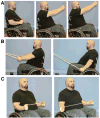Effectiveness of home exercise on pain, function, and strength of manual wheelchair users with spinal cord injury: a high-dose shoulder program with telerehabilitation
- PMID: 24887534
- PMCID: PMC4182115
- DOI: 10.1016/j.apmr.2014.05.004
Effectiveness of home exercise on pain, function, and strength of manual wheelchair users with spinal cord injury: a high-dose shoulder program with telerehabilitation
Abstract
Objective: To test the effectiveness of a high-dose home exercise/telerehabilitation program for manual wheelchair users who have a spinal cord injury (SCI) by determining whether the intervention would reduce pain and increase function, as we hypothesized.
Design: A pre-post trial with outcomes measured at 3 time points: baseline, postintervention (12wk), and follow-up (>24 wk).
Setting: Subjects performed an exercise program at their homes using telerehabilitation for therapist monitoring of technique and exercise advancement. Baseline and postintervention data were collected at a motion analysis laboratory in a tertiary medical center.
Participants: A convenience sample of manual wheelchair users (N=16, 3 women; average age, 41y; average time in a wheelchair, 16y) with shoulder pain (average pain duration, 9y) and mechanical impingement signs on physical examination.
Interventions: A 12-week home exercise program of rotator cuff and scapular stabilization exercises was given to each participant. The program included a high dose of 3 sets of 30 repetitions, 3 times weekly, and regular physical therapist supervision via videoconferencing.
Main outcome measures: Primary outcomes of pain and function were measured with the Wheelchair User's Shoulder Pain Index (WUSPI), Disabilities of Arm, Shoulder, and Hand (DASH) Index, and Shoulder Rating Questionnaire (SRQ). Secondary outcomes of strength were measured with isometric strength tests of scapulothoracic and glenohumeral muscles, and a static fatigue test of the lower trapezius.
Results: Pain was reduced and function improved after the intervention. There was a significant main effect for pain and function between the 3 time points based on the Friedman signed-ranked test, WUSPI (χ(2)2=5.10, P=.014), DASH Index (χ(2)2=5.41, P=.012), and SRQ (χ(2)2=23.71, P≤.001). Wilcoxon signed-rank tests demonstrated that isometric strength measurements of the serratus anterior and scapular retractors increased after the exercise intervention ([t=2.42, P=.04] and [t=4.67, P=.003], respectively). Muscle impulse produced by the lower trapezius during a fatigue task also improved (t=2.2, P=.02). No differences were measured in isometric strength for the lower trapezius, glenohumeral rotators, and abductors between the baseline and 12-week time points.
Conclusions: A high-dose scapular stabilizer and rotator cuff strengthening program using telerehabilitation for supervision holds promise for shoulder pain treatment in manual wheelchair users with SCI. Additional work is needed to determine the effectiveness compared with other interventions, as well as the potential for earlier intervention to prevent development of shoulder pain.
Keywords: Exercise therapy; Rehabilitation; Shoulder impingement syndrome; Spinal cord diseases; Telemedicine.
Copyright © 2014 American Congress of Rehabilitation Medicine. Published by Elsevier Inc. All rights reserved.
Figures


Similar articles
-
Ultrasound-guided platelet-rich plasma injection for the treatment of recalcitrant rotator cuff disease in wheelchair users with spinal cord injury: A pilot study.J Spinal Cord Med. 2022 Jan;45(1):42-48. doi: 10.1080/10790268.2020.1754676. Epub 2020 May 7. J Spinal Cord Med. 2022. PMID: 32379581 Free PMC article. Clinical Trial.
-
Shoulder mechanical impingement risk associated with manual wheelchair tasks in individuals with spinal cord injury.Clin Biomech (Bristol). 2020 Jan;71:221-229. doi: 10.1016/j.clinbiomech.2019.10.017. Epub 2019 Oct 20. Clin Biomech (Bristol). 2020. PMID: 32035338 Free PMC article.
-
Clinical trial of exercise for shoulder pain in chronic spinal injury.Phys Ther. 2006 Dec;86(12):1604-18. doi: 10.2522/ptj.20060001. Phys Ther. 2006. PMID: 17138842 Clinical Trial.
-
Effectiveness of Exercise Programs for Management of Shoulder Pain in Manual Wheelchair Users With Spinal Cord Injury.J Neurol Phys Ther. 2015 Oct;39(4):197-203. doi: 10.1097/NPT.0000000000000103. J Neurol Phys Ther. 2015. PMID: 26308939 Review.
-
Rehabilitation of shoulder impingement syndrome and rotator cuff injuries: an evidence-based review.Br J Sports Med. 2010 Apr;44(5):319-27. doi: 10.1136/bjsm.2009.058875. Br J Sports Med. 2010. PMID: 20371557 Review.
Cited by
-
Home-Based Tele-Exercise in Musculoskeletal Conditions and Chronic Disease: A Literature Review.Front Rehabil Sci. 2022 Feb 24;3:811465. doi: 10.3389/fresc.2022.811465. eCollection 2022. Front Rehabil Sci. 2022. PMID: 36188988 Free PMC article. Review.
-
Asynchronous and Tailored Digital Rehabilitation of Chronic Shoulder Pain: A Prospective Longitudinal Cohort Study.J Pain Res. 2022 Jan 8;15:53-66. doi: 10.2147/JPR.S343308. eCollection 2022. J Pain Res. 2022. PMID: 35035234 Free PMC article.
-
The health benefits and constraints of exercise therapy for wheelchair users: A clinical commentary.Afr J Disabil. 2017 Sep 8;6:337. doi: 10.4102/ajod.v6i0.337. eCollection 2017. Afr J Disabil. 2017. PMID: 28936414 Free PMC article.
-
Scapulothoracic and Glenohumeral Kinematics During Daily Tasks in Users of Manual Wheelchairs.Front Bioeng Biotechnol. 2015 Nov 20;3:183. doi: 10.3389/fbioe.2015.00183. eCollection 2015. Front Bioeng Biotechnol. 2015. PMID: 26636073 Free PMC article.
-
Models of Telehealth Service Delivery in Adults With Spinal Cord Injuries: Scoping Review.JMIR Rehabil Assist Technol. 2023 Jun 29;10:e41186. doi: 10.2196/41186. JMIR Rehabil Assist Technol. 2023. PMID: 37384377 Free PMC article.
References
-
- Curtis KA, Tyner TM, Zachary L, et al. Effect of a standard exercise protocol on shoulder pain in long-term wheelchair users. Spinal Cord. 1999;37:421–9. - PubMed
-
- Gellman H, Sie I, Waters RL. Late complications of the weight-bearing upper extremity in the paraplegic patient. Clin Orthop Relat Res. 1988;233:132–5. - PubMed
-
- Brose SW, Boninger ML, Fullerton B, et al. Shoulder ultrasound abnormalities, physical examination findings, and pain in manual wheelchair users with spinal cord injury. Arch Phys Med Rehabil. 2008;89:2086–93. - PubMed
-
- Alm M, Saraste H, Norrbrink C. Shoulder pain in persons with thoracic spinal cord injury: prevalence and characteristics. J Rehabil Med. 2008;40:277–83. - PubMed
Publication types
MeSH terms
Grants and funding
LinkOut - more resources
Full Text Sources
Other Literature Sources

